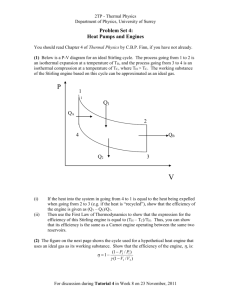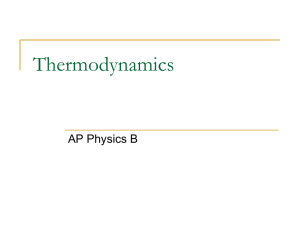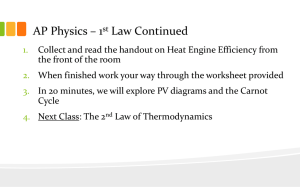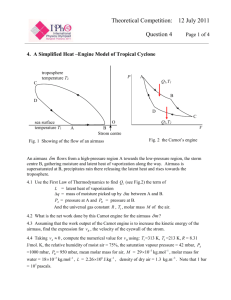Second Law of Thermodynamics Second Law of Thermodynamics.
advertisement
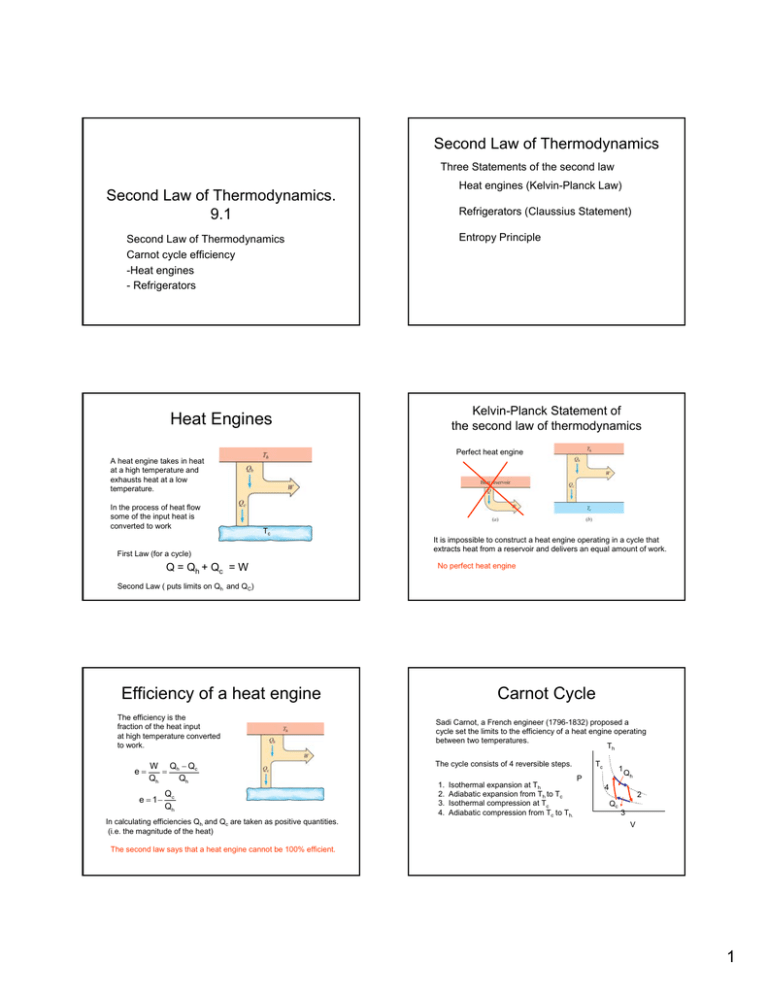
Second Law of Thermodynamics Three Statements of the second law Heat engines (Kelvin-Planck Law) Second Law of Thermodynamics. 9.1 Refrigerators (Claussius Statement) Entropy Principle Second Law of Thermodynamics Carnot cycle efficiency -Heat engines - Refrigerators Kelvin-Planck Statement of the second law of thermodynamics Heat Engines Perfect heat engine A heat engine takes in heat at a high temperature and exhausts heat at a low temperature. In the process of heat flow some of the input heat is converted to work Tc First Law (for a cycle) Q = Qh + Qc = W It is impossible to construct a heat engine operating in a cycle that extracts heat from a reservoir and delivers an equal amount of work. No perfect heat engine Second Law ( puts limits on Qh and QC) Efficiency of a heat engine The efficiency is the fraction of the heat input at high temperature converted to work. e= W Qh − Q c = Qh Qh e = 1− Qc Qh In calculating efficiencies Qh and Qc are taken as positive quantities. (i.e. the magnitude of the heat) Carnot Cycle Sadi Carnot, a French engineer (1796-1832) proposed a cycle set the limits to the efficiency of a heat engine operating between two temperatures. Th Tc The cycle consists of 4 reversible steps. 1. 2. 3. 4. Isothermal expansion at Th Adiabatic expansion from Th to Tc Isothermal compression at Tc Adiabatic compression from Tc to Th. 1 P Qh 4 2 Qc 3 V The second law says that a heat engine cannot be 100% efficient. 1 Heat engine undergoing the Carnot cycle. Heat engine. Work is done by the gas in expansion Work must be done on the gas to compress it to the initial state Efficiency of the Carnot cycle Heat transfer in the Carnot cycle In the Carnot cycle the magnitude of the heat transferred at T is proportional to the absolute temperature T. Qh Th = Qc Tc (here Q is always positive) From the relations Isothermal expansion and compression Tc e = 1− A1 P 4 D Qc Qh B 2 3 e = 1− C Th VA γ-1 = Tc VDγ-1 VB VC = VA VD Tc A1 P 4 D Qc Tc Th Qh B 2 3 C V The efficiency only depends on the ratio of the absolute temperatures. The efficiency would be 100% if Qc =0. Adiabatic expansion and compression ThVBγ-1 = TcVcγ-1 Qc Qh becomes V V Qc = RTc ln C VD V Qh = RTh ln B VA Th Th This is only possible if Tc = 0 K (i.e absolute Zero) Qh Qc = Th Tc A temperature of absolute zero cannot be attained. (Third law of thermodynamics) Carnot’s Theorem All Carot engines operating between temperatures Th and Tc have the same efficiency. T e = 1− c Th No other heat engine operating between these temperatures can have a greater efficiency Stirling Engine Maximum efficiency is less than the Carnot efficiency. Isothermal Th Q2 = Q 4 w2 =w4 =0 then e= Qin − Qout Q1 − Q3 = Qin Q1 + Q 4 For isothermal processes same volume change then P Q1 Q3 = Th Tc ⎛ ⎜ 1 e = ecarnot ⎜ ⎜ Q4 ⎜ 1+ Q 1 ⎝ ⎞ ⎟ ⎟ ⎟ ⎟ ⎠ Q4 Q1 Q3 Isothermal Tc Q2 V Efficiency lower due to extra heat added. 2 Clausius Statement of the Second Law of Thermodynamics. Refrigerator and heat pump Th Tc A1 P 4 D Qc Qh B 2 3 C V It is impossible to construct a refrigerator operating in a cycle whose sole effect is to transfer heat from a cooler object to a hotter one. Heat always flows from high temperature to low temperature. A heat engine run in reverse is a refrigerator and heat pump. Work is done to move heat from a cold temperature source to a hot sink. This device and be used for cooling or heating. Equivalence of the Kelvin-Planck and Clausius statements. Proof of the Carnot Principle higher efficiency engine If a perfect refrigerator were possible (Clausius) then a perfect heat engine could be constructed (Kelvin-Planck). Thus, the impossibility one implies the impossibility of the other. Carnot engine reversed If a heat engine with a higher efficiency than a Carnot engine could exist. Then it could convert heat to work with 100% efficiency. The Carnot engine has the highest efficiency for any heat engine acting between two temperatures. Example Real Heat Engines work done in expansion In a wood burning power plant the steam in the turbine operates between the high temperature of 810 K and a low temperature of 366 K. What is the Carnot efficiency for this plant. e = 1− Tc Th = 1− 366 = 0.55 810 Compare this to the efficiency calculated from the electrical power output of 59 MW and heat power input of 165 MW (see prob. 60) Qh Qc heat must be removed to condense the gas e= W P 59MW = = = 0.35 Qh H 165MW The actual efficiency is less than the Carnot efficiency. Power Plant 3 How to improve the efficiency of a heat engine. Cogeneration Use of waste heat Increase Th This requires high temperature materials Decrease Tc This requires efficient heat transfer. . This power plant in Denmark uses the waste heat to heat green houses nearby. Refrigerators The refrigerator uses a liquid with a low boiling point. The evaporation takes up heat from the refrigerator and the condensation of the gas releases the heat outside the refrigerator. Coefficient of performance COP- the heat removed from the cold source divided by the work done. COP = since 2 Heat exchange coils - the heat is released from the gas and exhausted outside of the refrigerator. Tc Th − Tc 3 Expansion valve – The pressure is decreased after going through the valve. The gas is cooled Qh Qc = Th Tc 1 2 3 4 Cooling coils- Heat is absorbed from within the refrigerator. The gas is heated. Refrigerator A freezer is kept at a temperature of 0o F. What is the maximum COP for a Carnot refrigerator with output temperature of 85o F. If the electrical energy use is 500kWh/year how much heat is removed in one year, assume 90% conversion of electrical energy to work. COP COP = 4 1 Compressor – gas is compresses and heated Qc Qc = w Qh − Qc The maximum Carnot COP COP = Refrigerator Tc 255 = = 5 .4 302 − 255 Th − Tc Tc = ( 0 -32)(5/9) +273=255 K Th =(85-32)(5/9)+273=302 K Work ⎛ 60min ⎞ ⎛ 60s ⎞ 9 W = 0.9(500 x103 W ⋅ hr ) ⎜ ⎟⎜ ⎟ = 1.62 x10 J ⎝ hr ⎠ ⎝ min ⎠ Heat Q COP = c w Qc = COP (w ) = 5.4 x1.62 x109 = 8.7 x109 J Summary • The second law of thermodynamics limits the efficiency of heat engines to less than 100% • The Carnot cycle is a reversible cycle taking in heat at high T and exhausting heat at low T. • The maximum efficiency of a heat engine working between two temperatures is the Carnot efficiency that depends only on the ratio of the absolute temperatures. • Refrigerators and heat pumps are heat engines run in reverse. • The maximum coefficient of performance is determined by a Carnot cycle. Heat removed 4




